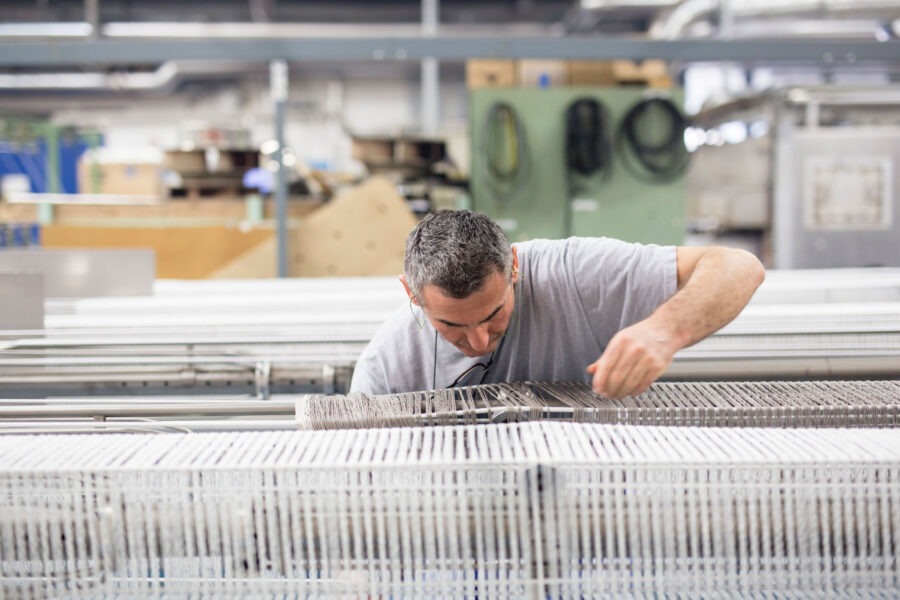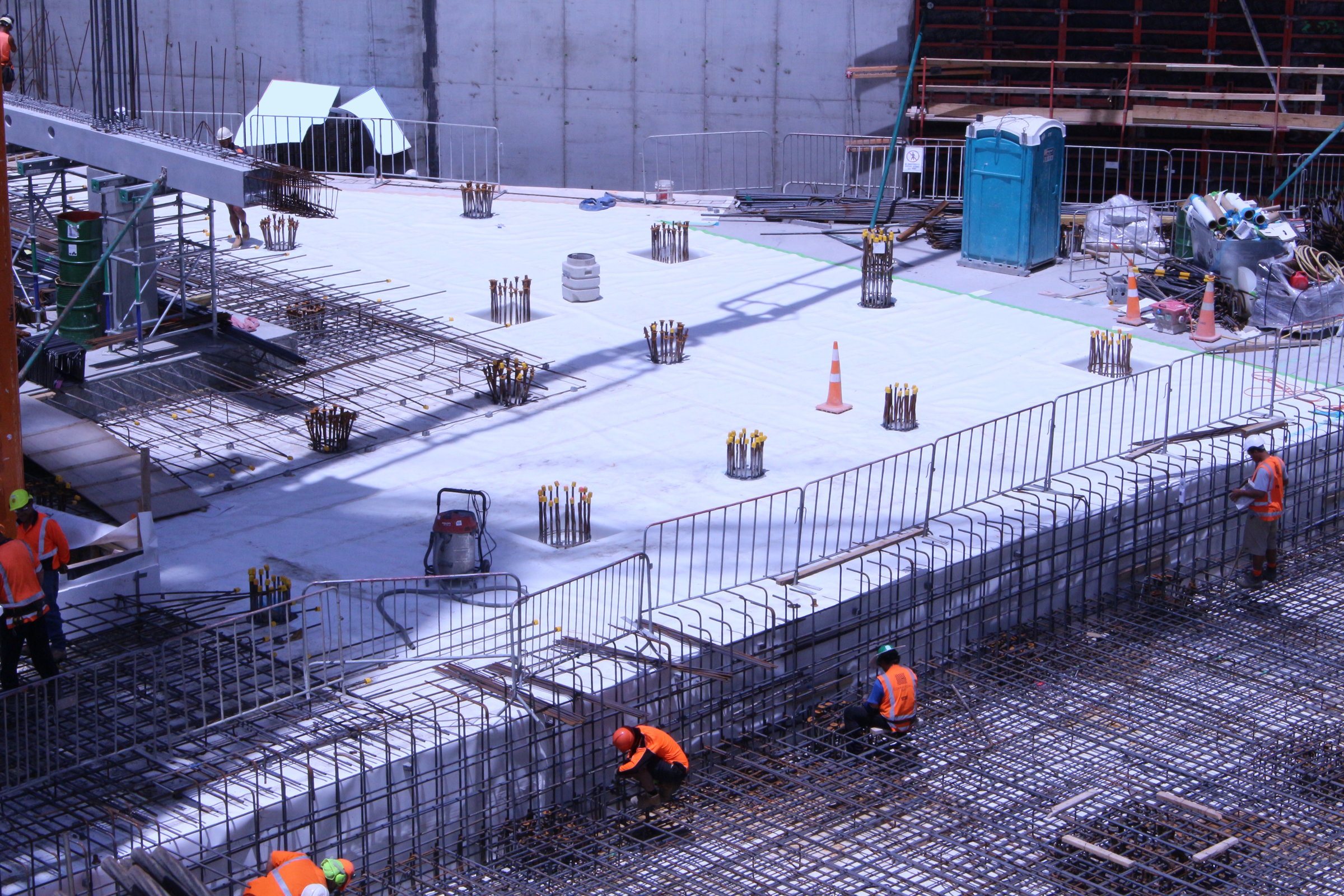Story at a glance:
- Material selection for the built environment has significant environmental and human health impacts.
- Reducing the embodied carbon and water of a building through sustainable material selection is an important feature of circular design.
In its 2023 document Building Materials and the Climate: Constructing a New Future, the United Nations Environment Program reports that the carbon emissions from producing building materials grew from 15% in 1995 to 23% in 2015. As the building industry comes under increasing scrutiny to lower its emissions, sustainable material selection becomes more important than ever.
Let’s explore some ways architects and engineers can do so using circular design principles.
What is Circular Design in Material Selection?

The bar top at Maxwells Trading features concrete and wood, using reclaimed live edge walnut slabs and burying the live edge with concrete. Photo by Jeff Marini
A circular or whole life cycle approach to material selection emphasizes the choice of materials that are easily reused or upcycled—or at least recycled rather than being landfilled. It is regenerative, low-carbon, and minimizes both energy and water consumption. Materials with these characteristics usually have little to no adverse impact on the health and well-being of a building’s occupants.
In material selection using circular design, all stages of a material’s production, use, and disposal are considered from extraction to end-of-life. The ultimate goal is to reuse a material, thereby eliminating—or at least reducing—waste.
Key principles of circular design that should guide material selection include:
● Incorporating reclaimed building materials wherever possible in new builds or major renovations
● Designing with ease of disassembly in mind to facilitate reuse such as with modular products
● Eliminating waste by leasing materials like ceiling tiles or carpet that can be reused or recycled
● Ending pollution generated by the production, use, or disposal of the material
● Fashioning materials to be long-lasting
● Substituting toxic chemicals and additives with safer alternatives
● Creating a materials bank using building information modeling that assigns an ID to each material like a passport in a shareable database to encourage reuse
Material Selection in Circular Design
Whether a designer or engineer is creating a totally new material or looking for a suitable material for their project, they consider not only how the material will serve the end user and its cost. They must also consider the material’s environmental and social impacts from its beginning to its end. In other words, material selection in circular design necessitates a systems mindset.
To assist them in material selection, knowledge of Environmental Product Declarations (EPDs) and Health Product Declarations (HPDs) of materials will enable them to address the following questions:
1. What are the design requirements for the material? High on the list are upgradability and ease of repair.
2. What are the materials selection criteria? Using fewer raw materials—dematerialization—is preferred.
3. Are there any candidate materials already in existence? Check out the databases profiled below.
4. How will candidate materials be evaluated? EPDs and HPDs are at the top of the list.
The Circular Design Guide is full of tools, methods, and resources as well as a section of case studies highlighting the successes of several circular designers.
Sustainable Sources for Green Material Selection
For designers and builders just beginning the material selection process, these sources list sustainable products or product components that may meet your needs.
Cradle to Cradle–certified products listed by category and level of certification. Built environment and furnishings is one kind of category while packaging is another.
There are also GreenScreen–certified products and chemicals. Examples include furniture and fabrics, textile chemicals, and reusable food packaging.
Resources for New Material Creation
Engineers and designers who wish to develop a new building material may begin the process by consulting these databases full of information on the safety and sustainability of chemicals:
● ChemForward is a cloud-based chemical hazard screening platform that enables users to design safe and environmentally friendly materials. Safer ingredients already in existence are listed by their trade names. The chemical hazard assessments are synced with C2C chemical ratings and the Globally Harmonized System of Classification and Labeling of Chemicals developed by the UN.
● Materiom uses open data and AI to assist users in creating bio-based materials appropriate for textiles, the built environment, and more. The database contains information on the components of biomaterials, how they’re produced, and their performance properties. With this platform, you can connect with more than 6,000 members in 50+ countries.
Examples of Sustainable Material Selection

ECONYL nylon is made in the Aquafil Arco facility. Photo courtesy of ECONYL by Aquafil
Here are a few examples of sustainable material selection for building projects, inside and out.
Econyl by Aquafil
Closing the loop in carpeting and textiles and winning several sustainability certifications along the way including a Cradle to Cradle certification, Aquafil recycles used carpets into upcycled ones in its numerous centers around the world.
ECONYL regenerated nylon is made from 100% waste instead of oil and offers up to 90% reduction in global warming potential compared to nylon from fossil sources, according to Giulio Bonazzi, CEO of Aquafil Group.
ECONYL can be recycled an infinite number of times and maintains the same quality as standard nylon made from oil but with a much lower environmental impact. The company collects carpet waste through its US carpet recycling facilities, collects industrial waste from partners around the world, and collaborates with the aquaculture industry to recover fishing nets. ECONYL regenerated nylon has supported more than 1,700 partnering brands, including Patagonia, in their journey toward sustainability.
St. Regis Chicago
St. Regis Hotel and Residences in Chicago, targeting LEED Silver certification, used low-emitting adhesives, sealants, paints, and coatings to reduce VOCs and improve indoor air quality.
“At a high level following the credits and protocols of LEED really helps us better select things like materials and finishes, the products used within the building, lighting, the HVAC systems—pretty much everything comes with a certain performance requirement attached to it that really helps promote and drive sustainability and also occupant health and wellness,” Scott Farbman, design engineer and LEED consultant on the St. Regis project, previously told gb&d.
jeann
Porcelain tile is an ideal material selection for building climate resilience. MILE®stone by Florim USA is a standout porcelain tile that be used indoor and out. The natural, inert material has a high solar reflectance index that, when clipped to the exterior of a building as cladding, moderates building temperature and reduces energy costs.
“Porcelain cladding used with a fire-resistant roofing material like metal or ceramic and traditional fire mitigation measures like vegetation management produces a resilient structure that is not prone to catch fire from falling embers or contribute to the spread of wildfire. In some cases porcelain tile used in interior structures can act as a flame retardant, helping to slow the spread of flame and increase the chances of exiting safely. Conversely, many other flooring choices are not only highly flammable; they can also emit harmful volatile organic compounds when exposed to heat and reduce the risk of survival,” Don Haynes, environmental/sustainability manager for Florim USA, previously wrote for gb&dPRO.



